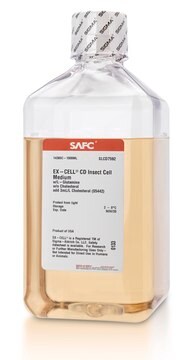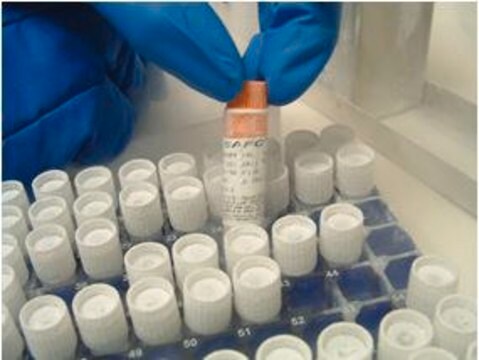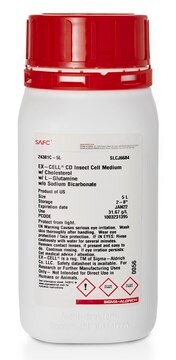SFRVN
Sf-RVN™ Insect Cell Line
Synonym(s):
Sf9 rhabdovirus-negative (Sf-RVN™) Insect Cell Line
About This Item
Recommended Products
description
Sf9 rhabdovirus-negative (Sf-RVN™) Insect Cell Line
solubility
DMSO: 10%
shipped in
liquid nitrogen
storage temp.
−196°C
General description
Cell Line Origin
Sf-RVN™ is an insect cell line originally derived from ovarian tissue of Spodoptera frugiperda (Sf) pupae. The parental line, IPLB-SF-21 (renamed IPLB-SF-21 AE after adaptation into TC-100 medium), was established by J. Vaughn at the Insect Pathology Beltsville in Maryland, USA in the late 1960s. A subclone, designated Sf9, was established in 1983 by G. Smith and C. Cherry. Sf-RVN™ was isolated from Sf9 by GlycoBac, LLC.
Physical form
Other Notes
Legal Information
related product
Storage Class Code
12 - Non Combustible Liquids
WGK
WGK 1
Flash Point(F)
Not applicable
Flash Point(C)
Not applicable
Choose from one of the most recent versions:
Certificates of Analysis (COA)
Sorry, we don't have COAs for this product available online at this time.
If you need assistance, please contact Customer Support.
Already Own This Product?
Find documentation for the products that you have recently purchased in the Document Library.
Articles
See how the Sf9 rhabdovirus-free cell line was developed and how we’ve developed a companion chemically-defined insect cell media for protein and viral expression.
To address scalability challenges of AAV manufacturing, we developed an HEK293 suspension cell line that can be used across many serotypes. Get the data in this article.
Optimizing the upstream portion of gene therapy production sets the stage for successful manufacturing by maximizing viral vector titers. To increase upstream titers and process productivity, manufacturers must partner with upstream technology experts who work with HEK293, HEK293T and Sf9 cells. Draw on our experience today to speed your gene therapy to patients.
This technical article breaks down the steps of upstream and downstream bioprocessing and formulation of virus-like particle vaccines.
Related Content
The new Sf-RVN® Platform provides a high performant rhabdovirus-free alternative to produce recombinant proteins, virus-like particles (VLP) for viral vaccines, and adeno-associated viruses (AAV) to treat genetic diseases, improving the safety profile of your gene therapy and vaccines.
A transfection-based solution to viral vector production using a suspension cell line, chemically defined medium, and a process with proven performance at scale.
Our team of scientists has experience in all areas of research including Life Science, Material Science, Chemical Synthesis, Chromatography, Analytical and many others.
Contact Technical Service






